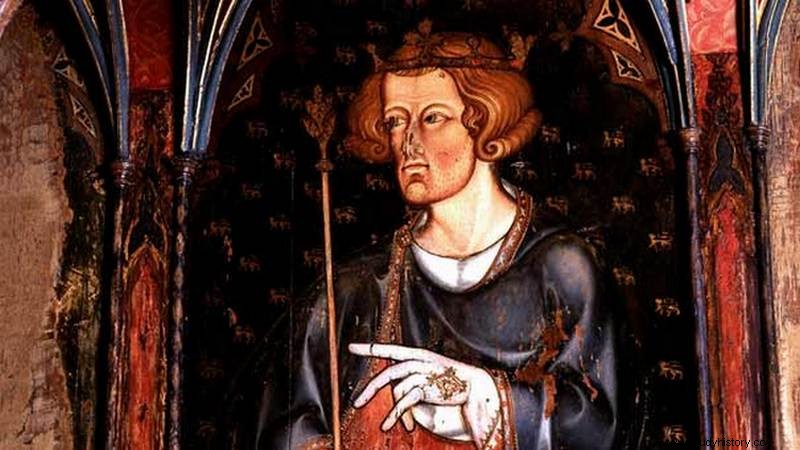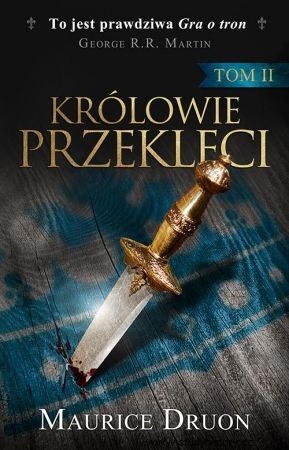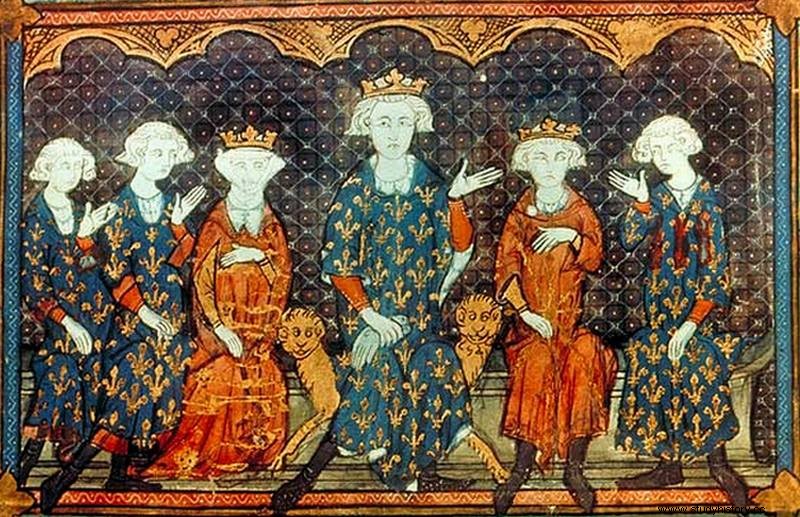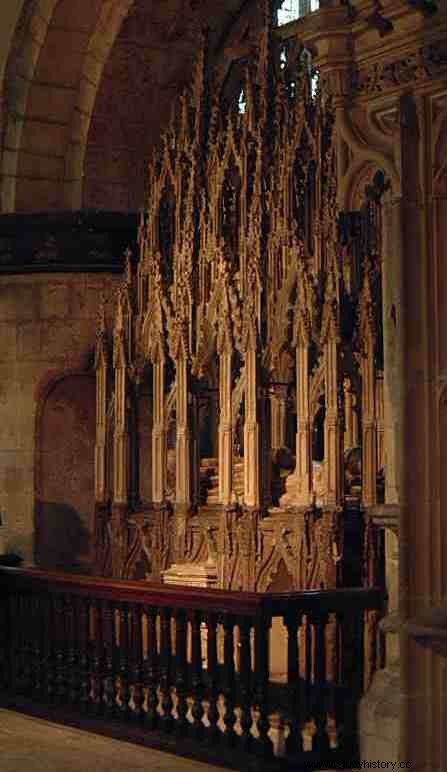It was enough for this effeminate idiot to appear in the crown, and the entire prestige of the royal majesty fell with a bang. English King Edward II would move heaven and earth for a lover, but not necessarily for a country. No wonder this love story didn't have a happy ending.
The future Edward II was born in 1284 as the last son of King Edward I the Long-legged and Eleanor of Castile. After the death of his older brother Alfonso, he was heir to the throne when he was only a year old.
As it turned out very soon, he did not live up to the expectations of his great father. Not only did he lack military talents, but he also made too strong and suspicious friendships . The Gascon knight Piers Gaveston, who contributed to the tragic end of his ruler, was to bring the most problems.

Edward II's father, Edward I the Long-legged, was a strong and determined ruler. However, he did not achieve the expected success in choosing a companion for his son ... (source:public domain).
There was supposed to be a friend, but he was gosh
In 1297, Gaveston took part in a military expedition organized by Edward I to Flanders, and it was probably the king himself who introduced him - ironically - to his son's court. A few years older than the prince, handsome and well-built, he seemed to be the perfect companion to the heir to the throne.

This article was inspired by the second volume of Maurice Druon's novel "Cursed Kings" (Open Edition 2015).
If you believe the records of the "Chronicle of the Civil Wars of Edward II", the prince fell in love with the Breast at first sight and then "joined him in spite of the whole world with unbreakable bonds of love". And although there is no real evidence that the prince entered into a deeper relationship with the Gasconian before 1305, he certainly had a serious quarrel with his father over him, for which the king not only cut off his son from money, but also removed several courtiers from his entourage. including Gaveston.
A certain consolation for Edward I could be the fact that the future ruler had already become the father of at least one bastard - a son named Adam. This might have reassured Longlegged that even if there was some truth in the rumors, the dynasty would not be threatened. The heir to the throne would soon marry Isabella of France and engage in the procreation of legitimate descendants. Meanwhile, he preferred to strengthen the position of his favorite.
The king loves "beyond measure" but not the queen
On August 6, 1308, Gaveston became Earl of Cornwall, and on November 1, Edward II, King of England for a year, married him to Margaret de Clare, sister of the Earl of Gloucester, and gave the couple a lavish wedding. The newlyweds were showered with gifts, but the nobles were furious. Piers' growing position had an impact on the king's popularity and resulted in divisions between him and the magnates.

The king, despite the unfavorable looks of the courtiers, spent a nice time with his beloved (Marcus Stone's painting "Edward II and his favorite, Piers Gaveston", public domain).
The atmosphere was tense already at the beginning of the year, when the king married 12-year-old Isabella Franca, the beloved daughter of Philip IV the Beautiful. Edward was 23 years old and undoubtedly a good-looking man - well-built, lean, energetic. Unfortunately, if young Izabela was counting on romantic love, she would soon be disappointed. After arriving in her new homeland, she only gained an inferior position in the heart of her husband.
In his novel "The Cursed Kings", Maurice Druon puts these words into the mouth of the unhappy queen:
The queen lives the most miserable life of all her kingdom's subjects if her own husband stopped loving her. It was enough to ensure the continuity of the dynasty, then its fate became indifferent to the king. […] The last laundress of the kingdom has more rights than I do because he can come and seek support from me.
By contrast, chroniclers have repeatedly described Edward's love for Gaveston, using words such as beyond measure and reason , unrestrained , immoderate and excessive . The author of "The Life of Edward II" wrote: In fact, I do not remember that I have ever heard one man love the other so ... Our king was incapable of moderate affect .
This article has more than one page. Please select another one below to continue reading.Attention! You are not on the first page of the article. If you want to read from the beginning click here.
However, with time it turned out that the king also visited his wife's alcove on his way. In 1312, the sixteen-year-old queen gave birth to the heir to the throne, the future Edward III. She and her husband were looking forward to having three more children. And although the marital life of the royal couple certainly left much to be desired, and Edward and Isabella did not spend much time together, they effectively ensured the continuity of the dynasty.

King Edward II feasts ... without a wife, of course (source:public domain).
The royal lover shines in the salons
Edward II's coronation took place on February 25, 1308 - a week later than planned. The delay was due to the demand for Gaveston's exile - from both the English nobility and the French royal family. A year earlier, in October, the king ordered tapestries with the coats of arms of the royal and the count of Cornwall, which were to be displayed during the coronation. Not only did they stab the magnates in the eyes, but also, to the horror of the entire court, Gaveston carried the crown of St. Edward, in procession before the king. He also wielded a ceremonial sword and spiked the king on his left foot.
However, the presence of the royal favorite at the coronation was nothing compared to the events that had taken place a month earlier at the royal wedding banquet. When Piers arrived at the wedding feast clad in royal scarlet and pearls, it was considered a desire for for his own glory rather than for the king's glory . One of the chroniclers reported that he seemed more like the god Mars than the ordinary mortal .
Many at the king's wedding feast were indignant at how little time the king devoted to his wife compared to his favorite. Isabella's uncles - Louis of Evreux and Charles of Valois - felt so deeply offended that they quickly left England, and one of the counts wanted to kill Gaveston immediately.
In the spring of 1308, Isabella was reported to have complained to her father about ill-treatment, and rumors spread throughout England that the French king was plotting against the royal favorite (if not against Edward himself). Under pressure from all sides, on May 18, Edward capitulated and agreed to expel Gaveston, but sweetened his exile with the title of Viceroy of Ireland.

Edward II's wife definitely preferred to spend time with her French family than with her husband. From the left:her brothers Karol and Filip, Izabela himself, her father, King Philip IV the Beautiful, her brother Ludwik and uncle Karol Walezjusz (source:public domain).
In January 1312 a daughter was born to Piers, so he took the risk and returned to the country from exile. The overjoyed king sent letters confirming the loyalty of his favorite, and considered the exile to be contrary to the laws and customs of the country. He got his way and in April they were back together again.

This article was inspired by the second volume of Maurice Druon's novel "Cursed Kings" (Open Edition 2015).
The idyll lasted only until June. One morning Gaveston was awakened by shouts of get up traitor, you are being captured! after which he was taken to Warwick Castle, where he was thrown in chains into the dungeons. In a hurry, the assembled council of barons and counts decided his fate, condemning him to death without trial. Two Welsh men beheaded him.
Holy sodomite?
After the death of his favorite, the king consoled himself in many arms. This did not gain him popularity and was eventually dethroned by a rebellion led by the queen. Edward's death was announced in parliament on September 21, 1327, and was accompanied by reports of the execution of the hated ruler.
The best known and most frequently repeated version of events is the one written a generation later by the chronicler Geoffrey le Baker. The king was about to be murdered with an incandescent iron rod inserted into the anus and the screams of the ruler were heard even in the neighboring village.

Tombstone of Edward II in Gloucester Cathedral - would-be center of the cult of his holiness (source:public domain).
Edward II rested in Gloucester Cathedral on December 20, 1327 as the only monarch of his dynasty, as they were traditionally buried in Westminster Abbey. The posterity did not remember his merits, because there was nothing to remember. Maurice Druon in his novel "The Cursed Kings" portrays him as the embodiment of his family's shame and disgrace:
Sloth and mess followed him step by step. The lightness and indifference with which he discussed state matters, which he considered to be the proper form for monarchs, offended lords, abbots and notables (...). The tenderness he showed to his omnipotent chamberlain, stroking his hand during a meeting or a mass, outbursts of high-pitched laughter, and freedom of manners, the victims of which were astonished clerics or grooms, only confirmed the scandalous stories circulating in the provinces (...).
Nevertheless, his son and successor, over time, made sure that his father was remembered and honored as a martyr and saint, cruelly deprived of a crown and of life. During the reign of his great-grandson, Richard II, Edward became a cult figure, and miracles apparently happened at the place of his burial. Ryszard unsuccessfully tried to canonize his ancestor, and the cult of Edward continued until the Reformation.
